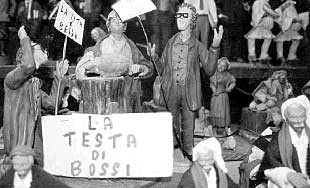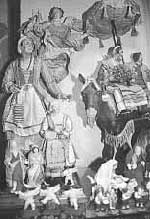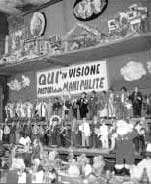From:
 ©
©Tuesday, December 21, 1999
DISTRIBUTED WITH THE
![]() ©
©
From:
 ©
©DISTRIBUTED WITH THE
![]() ©
©
On a recent afternoon in Naples, Ugo Esposito, owner and master craftsman of Pastori Artistici, a shop devoted to figures used in presepi or nativity scenes, talked excitedly about the worldwide growth of a Christmas tradition for which Naples is particularly well known.
"I've got clients all over the world faxing, e-mailing and calling up in the middle of the night," he says, leafing through a pile of faxes from Japan. "They can't get enough shepherds. The Internet is flooded with information about presepi - the whole world is copying Naples!" the craftsman continues, pointing out the exquisite work-manship of the tiny lifelike glass eye-balls, the arthritic fingers, and the five o'clock shadow that set his shepherds apart from the rest.
Recently Mr. Esposito said he even received a confidential e-mail from a big-wig in Hollywood saying he'd pay anything for a model of George Lucas, director of Star Wars fame, transformed into a proud miniature shepherd warrior with a shield.
Pastori Artistici - literally "Artistic Shepherds" - is one of countless shops lining the narrow Via San Gregorio Armeno and devoted to the craft of the crèche scene. Tables selling minuzie, or nativity scene trimmings, abound. For a quality presepe to be complete, the details have to be just right. Shoppers can pick and choose from miniature caged pigs, jugs of wine, pizza ovens, and eels that splash about in real, running water.
Need to update an outfit or repair an eyeball for one of the stars of the show? Head over to Antichità Francesco Campobasso, where a large selection of limbs, terra-cotta heads and designer regal wear are yours for a price. For over a century the Campobasso store has dealt exclusively in upscale manger accoutrements, including tiny silver swords, miniature golden pouches and hand sewn leather shoes for the figure of Virgin Mary.
This miniature world is big business. Prices range from 3,000 lire for a plastic mule to up to 10,000 lire for a sin-gle hand-carved shepherd. Also pricey is a deluxe electronic crèche with mooing cows, running water, twinkling stars and an image of cult Franciscan friar Padre Pio. Serious shoppers can spend up to 30 million lire on the manger set, figurines not included. Down the road, a tiny storefront shop called "Pastori dalle Mani Pulite," specializes in celebrity figurines of members of the Italian political firmament, many of whom fell prey to the probes of the Mani Pulite or Clean Hands pool of prosecutors investigating political corruption earlier this decade.
Other public figures captured by the fancy of Neapolitan craftsmen include Umberto Bossi, the leader of the Northern League, which for most of the 1990s has argued in favor of the wealthy North seceding from the rest of Italy. Just as Mr. Bossi doles out unfavorable comments on southern character with ease, in Naples he is not deemed worthy of a body, and his fig-urine consists of his head - neatly decapitated and laid next to sunglasses- clad superstar Roberto Benigni, arms thrown upwards and carrying the sign advertising his Oscar-winning Holocaust comedy, "Life Is Beautiful." President Carlo Azeglio Ciampi, European Commission President Romano Prodi and Senator Antonio Di Pietro, the former Clean Hands anti-corruption prosecutor, and Dr. Luigi Di Bella, the author of a debunked cancer cure are also among the sculpted entertainment in Naples this year. The world of the church is also represented, with the recently-deceased Albanian nun Mother Teresa and Cardinal Michele Giordano, the Archbishop of Naples caught up in an alleged usury ring run by his brother.
Elsewhere, children clamor round the latest trend - a presepe made purely of pasta. Using spinach noodles, squid ink rigatoni, and red pepper fusilli, a craftsman who gave his name only as Giuseppe said working with his preferred medium of pasta was akin to Michelangelo expressing the divine inspiration through stone. "I prefer pasta, the texture, the colors and shapes," he said, as he nestled the baby Jesus snugly onto a bed of spaghetti.
Presepi are a time-honored tradition in Naples. In Greco-Roman times, the streets around San Gregorio Armeno were lined with bakeries in honor of the goddess of grain, Ceres. The intoxicating yeasty aroma of this holy air inspired artisans of the day to create devotional statuettes to her. With the arrival of Christianity this pagan art form was transformed to accommodate the new religion.
The origin of the Neapolitan presepe traces back to 1025. By the 15th centu-ry, through the artistry of the brothers Pietro and Giovanni Alemanno, the cast of characters began to grow. No longer limited to the symbolism of the medieval church, the modern nativity scene was born. Hand-carved wooden figurines, dressed in the fashions of the times were added as were farm animals and local landscapes.
The presepe reached its golden age in the 18th century, under the reign of the crèche-crazed Bourbon monarch Charles III. This regal aficionado, noto-rious for commissioning vast and spectacular works of art, is credited with creating a new year-round job, the figuraio, or figurine maker.
The king commissioned a magnificent presepe at Naples' Palazzo Reale, complete with mountain ranges, caves, streets bridges, taverns and shops. Over 150 angels were suspended over the Christ child, asleep in the manger, with real silver, precious gems and ancient coins at his feet.
Charles III surrounded himself with artists and architects and was active in all design aspects of the crèche, while his queen, together with other elegant ladies of the court, busied themselves creating tiny silk clothes and fashionable accessories for the figurines.
Naturally, Neapolitan nobles copied the sovereign's wild style, and well-endowed luxury presepi became all the rage. Yet the presepe also appealed to all levels of Neapolitan society. It served as a demonstration of faith as well as a way to flaunt one's riches, no matter how little.
Modern presepi are still made of the same core materials as the originals: cork, moss, and bark. They vary from humble shoebox sized mangers to jumbo villages the size of Fiats complete with infrastructures so orderly as to make modern Neapolitan weep.

In the latest departure from tradition, comic actor Roberto Benigni touts that "Life is Beautiful" next to the decapitated head of northern separatist leader Umberto Bossi.


Elaborate versions of traditional shepherds and donkeys vie with contemporary Italian political figures for shelf space in Naples.
All photos © Italy Daily/IHT 1999.
The Authors are responsible of their opinions - Gli autori sono responsabili delle loro opinioni - Los autores son responsables de sus opiniones
Disclaimer: All articles are put on line as a service to our readers. We do not get any economical advantage from it. Any copyright violation is involuntarily, we are ready to exclude any article if so requested by the author or copyright owner. Send a message to: copyright@duesicilie.org
![]() Lista/List
Lista/List